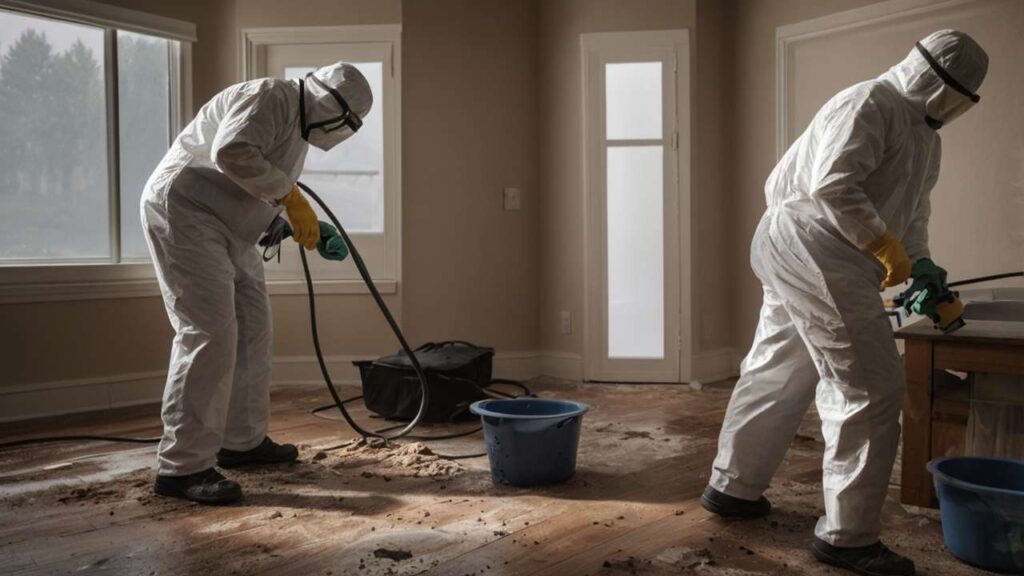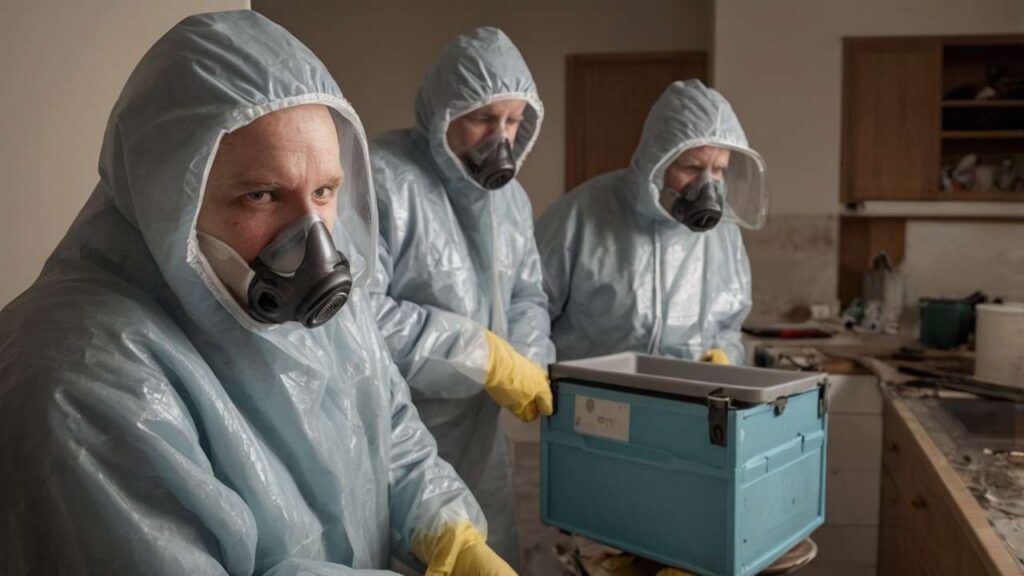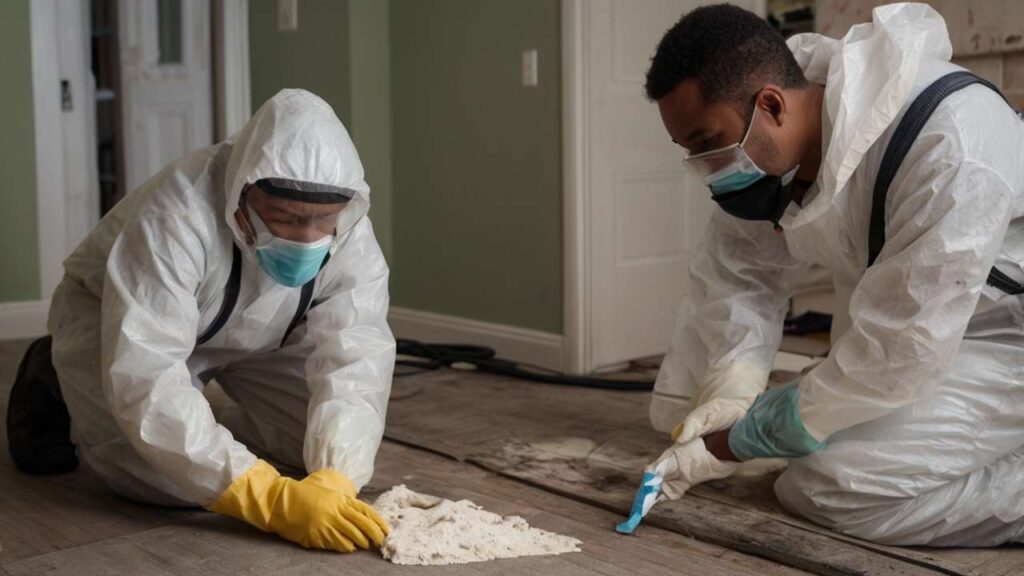Most homeowners, including myself at one point, have had that “quick fix” mindset: grab a bottle of bleach, scrub the mold, and hope it disappears. At first, it looks satisfying—the black stains fade, and the room smells “clean.” But the reality is harsh: bleach doesn’t kill mold roots. The problem comes back, sometimes worse than before, hidden behind walls or under flooring. That’s why understanding the professional mold remediation process is so important.
Bleach might feel cheap and convenient, but it’s a temporary mold fix with dangerous downsides. Mold colonies are not just surface-level stains; they are living organisms that anchor deep into porous surfaces. Using bleach is like trimming the top of a weed but leaving the roots untouched. And I can tell you from experience, the “roots” of mold always find their way back.
- Why Bleach Is Never Enough
- The Professional Mold Remediation Process
- Cost vs Value
- Tools Professionals Use That DIY Can’t Replace
- Why Size and Source Matter
- The Danger of Temporary Fixes
- Case Study: DIY Attempt Gone Wrong
- Certified Experts Are Worth It
- Expanding the Mold Conversation
- Frequently Asked Questions
Why Bleach Is Never Enough
Bleach is essentially a cosmetic cleaner. It can whiten the top of mold spots on non-porous materials, but in porous surfaces like drywall or wood, it does little to nothing. Professional mold experts often say, “Bleach makes mold invisible, not dead.” That invisibility gives homeowners a false sense of security while mold keeps growing underneath.
The dangers go beyond appearance. Breathing in spores from hidden growth can trigger health problems. If you’ve ever read Mold’s Silent Threat: Understanding the Health Risks and When to See a Doctor, you’ll understand why medical professionals take mold exposure seriously. From asthma flare-ups to severe allergic reactions, the consequences are not worth risking just to save a few dollars on proper remediation.
The Professional Mold Remediation Process
Certified specialists don’t show up with just bleach and a rag. They follow a multi-step process that targets mold at its source and prevents regrowth. From my observation of a project in a friend’s basement, the procedure felt more like a surgical operation than cleaning.
- Mold Containment – Experts seal off affected areas using plastic sheeting and negative air pressure machines. This ensures spores don’t travel to unaffected rooms during cleanup.
- Air Filtration – High-Efficiency Particulate Air (HEPA) filters and scrubbers are used to trap airborne mold spores. These machines often run continuously during the entire remediation to keep the air safe.
- Source Fix and Removal – Contaminated drywall, carpets, or wood panels are removed and replaced. In some cases, professional-grade mold killers are applied to salvage surfaces.
- Drying and Dehumidification – No matter how well removal is done, if humidity remains unchecked, mold returns. This is where moisture meters and industrial dehumidifiers play a crucial role.
- Documentation and Testing – Reliable companies provide before-and-after photos, humidity readings, and even lab testing of air quality to prove the job was successful.
Compare this to DIY mold removal vs expert methods, and the difference is like using duct tape on a leaking pipe versus replacing the damaged section entirely.
Cost vs Value
I get it—the cost of professional mold removal scares many homeowners. Depending on the size of contamination, prices can range from a few hundred to several thousand dollars. But consider the value. A homeowner who tries bleach DIY fixes might spend $20 today but risk thousands in structural repairs tomorrow.
There’s also the hidden cost of health. Mold spores lingering in your HVAC system spread everywhere, leading to medical bills and lost work days. As highlighted in More Than a Stain: The Structural Damage Caused by Untreated Household Mold, untreated mold weakens wood framing and can even compromise the structural integrity of a home. That cost is far higher than hiring a trusted, reliable expert in the first place.
Tools Professionals Use That DIY Can’t Replace
Walking into a remediation site, you’ll notice tools that look more like lab equipment than cleaning gear. HEPA air scrubbers for mold, commercial-grade dehumidifiers, and moisture detection meters are standard. Professionals also apply commercial-grade mold killer solutions that penetrate surfaces deeper than household cleaners.
A personal example: a neighbor’s attic had mold growth after a roof leak. He spent weeks trying vinegar, bleach, and online remedies. Finally, a certified expert came in with industrial equipment and cleared the space in two days. The difference wasn’t just speed—it was peace of mind.
Why Size and Source Matter
Assessing mold size is critical. A few square inches on bathroom tiles may be manageable with safe DIY cleaners. But anything over 10 square feet is considered beyond DIY scope, according to EPA guidelines. Professionals don’t just measure surface size—they investigate hidden water sources. Reading How to Identify and Control the 5 Sources of Home Humidity gives practical insight into how leaks, condensation, or poor ventilation fuel recurring mold. Without fixing these sources, no cleaning lasts long.
The Danger of Temporary Fixes
I’ve seen homeowners proudly announce, “I got rid of it with bleach!” only to call for help six months later. Temporary mold fix dangers include:
- Spread of spores to new areas during scrubbing
- Respiratory irritation from harsh chemicals
- Masking the problem instead of solving it
- Accelerating hidden growth behind walls
Experts stress that DIY methods may buy time, but they rarely eliminate the problem entirely. And time is the enemy, because mold doesn’t just sit still—it spreads.
Case Study: DIY Attempt Gone Wrong
A small daycare facility noticed mold spots near their windows. Staff members tried cleaning with bleach over summer break. By fall, the mold was back, now twice as large, creeping under the baseboards. Parents started reporting children with coughs and allergies. Only after hiring a certified mold expert did the facility realize that water leaks from the window seals were the true source. The repair plus remediation ended up costing three times more than if they had gone professional from the start.
Certified Experts Are Worth It
A certified mold expert brings more than equipment; they bring experience. They know how to recognize cross-contamination risks, when to use encapsulation techniques, and how to safely dispose of contaminated materials. “Mold work is about controlling environments, not just cleaning surfaces,” said Dr. Leonard Cruz, a building science specialist. His point hits home: the environment is everything.
If you’re in the Southeast, top-notch mold remediation services in North Carolina provide clear examples of expert-led results that last.
Expanding the Mold Conversation
Mold is not just a household nuisance—it ties into larger topics that deserve more awareness. Homeowners often overlook how mold can connect to energy efficiency, HVAC design, and even home insurance disputes. Discussions about eco-friendly building materials that resist moisture, or smart home sensors that alert to leaks early, are becoming more valuable every year.
Just like A Simple Prevention Checklist to Keep Mold Away Forever reminds us, prevention is not a one-time act. It’s ongoing care: maintaining proper ventilation, cleaning gutters, and monitoring humidity. Pairing this with reliable mold remediation knowledge helps keep homes safe, healthy, and financially protected.
Frequently Asked Questions
Q1: Can I ever use bleach for mold safely?
Bleach may work on non-porous surfaces like glass or ceramic, but it does not penetrate porous materials. It should never be relied on for long-term mold remediation.
Q2: What makes professional mold remediation different from DIY?
Professionals use containment systems, HEPA air scrubbers, and certified mold killers. They also address the source of moisture, which DIY rarely solves.
Q3: How much does professional mold removal cost compared to DIY?
DIY might cost under $50 in supplies but often fails. Professional mold removal typically costs hundreds to thousands, but it delivers lasting results and protects both health and property.
For homeowners seeking reliable, trusted information, exploring the mold remediation category or visiting Pro Service Tips directly can provide more detailed strategies. If you’re already facing mold issues, don’t settle for surface cleaning—understand why Why Bleach is Never the Long-Term Solution is more than just a saying.
Mold is stubborn, but with professional help, your home can be just as stubborn back. If this article gave you clarity or saved you from a costly mistake, share it on your social media using the buttons below. You might just save a friend from learning this the hard way.



